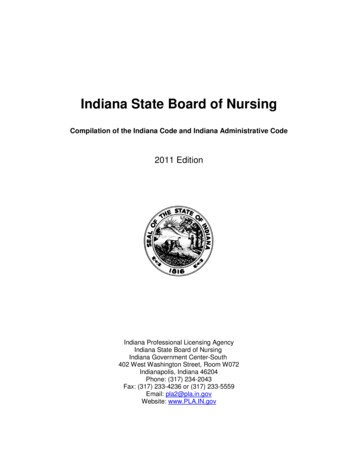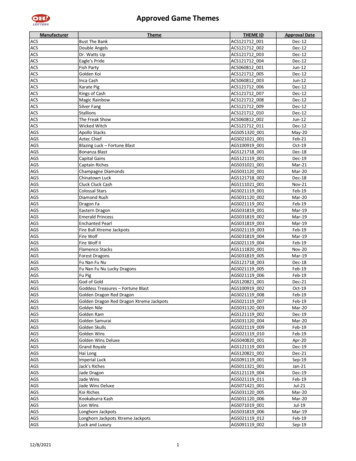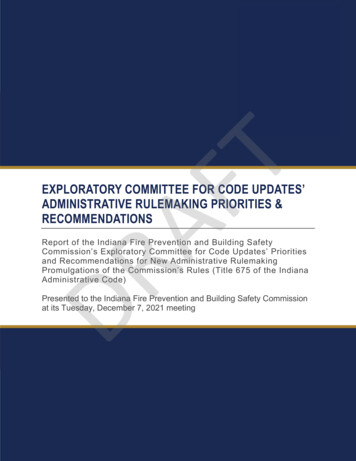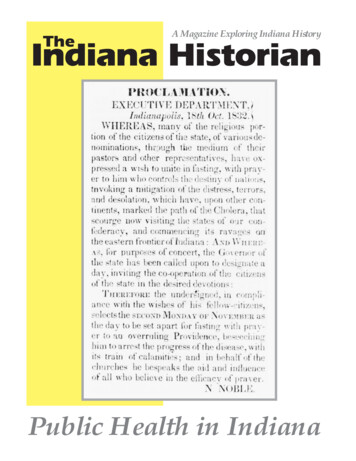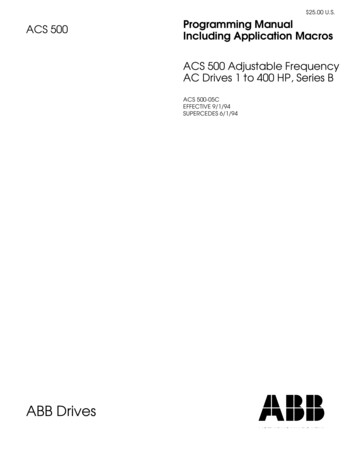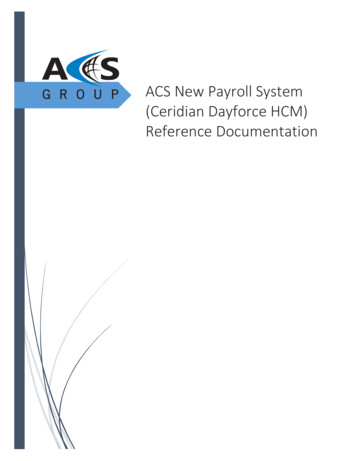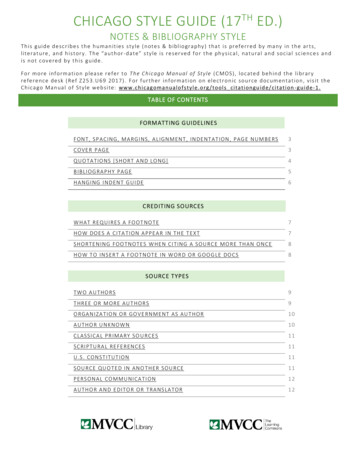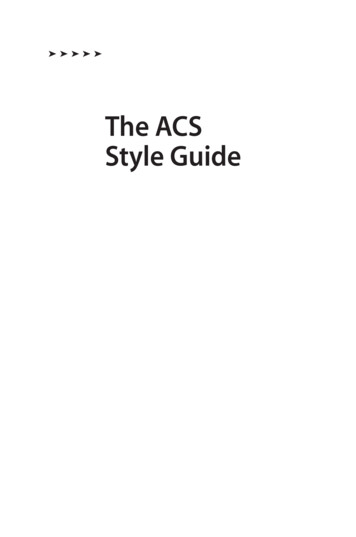
Transcription
The ACSStyle Guide
THIRD EDITIONThe ACSStyle GuideEffective Communicationof Scientific InformationAnne M. CoghillLorrin R. GarsonEditorsAMERICAN CHEMICAL SOCIETY Washington, DCOXFORD UNIVERSITY PRESS New York Oxford2006
Oxford University PressOxford New YorkAthens Auckland Bangkok Bogotá Buenos Aires CalcuttaCape Town Chennai Dar es Salaam Delhi Florence Hong Kong IstanbulKarachi Kuala Lumpur Madrid Melbourne Mexico City MumbaiNairobi Paris São Paulo Singapore Taipei Tokyo Toronto Warsawand associated companies inBerlin IdabanCopyright 2006 by the American Chemical Society, Washington, DCDeveloped and distributed in partnership by theAmerican Chemical Society and Oxford University PressPublished by Oxford University Press, Inc.198 Madison Avenue, New York, NY 10016Oxford is a registered trademark of Oxford University PressAll rights reserved. No part of this publication may be reproduced, stored in a retrievalsystem, or transmitted, in any form or by any means, electronic, mechanical, photocopying,recording, or otherwise, without the prior permission of the American Chemical Society.Library of Congress Cataloging-in-Publication DataThe ACS style guide : effective communication of scientific information.—3rd ed. /Anne M. Coghill [and] Lorrin R. Garson, editors.p. cm.Includes bibliographical references and index.ISBN-13: 978-0-8412-3999-9 (cloth : alk. paper)1. Chemical literature—Authorship—Handbooks, manuals, etc. 2. Scientific literature—Authorship—Handbooks, manuals, etc. 3. English language—Style—Handbooks, manuals,etc. 4. Authorship—Style manuals.I. Coghill, Anne M. II. Garson, Lorrin R. III. American Chemical SocietyQD8.5.A252006808'.06654—dc2220060406681 3 5 7 9 8 6 4 2Printed in the United States of Americaon acid-free paper
ContentsForeword. . . . . . . . . . . . . . . . . . . . . . . . . . . . . . . . . . . . . . . . . . . . . . . . . . . . . . . . . . . . . . . . viiMadeleine JacobsPreface . . . . . . . . . . . . . . . . . . . . . . . . . . . . . . . . . . . . . . . . . . . . . . . . . . . . . . . . . . . . . . . . . . .ixContributors. . . . . . . . . . . . . . . . . . . . . . . . . . . . . . . . . . . . . . . . . . . . . . . . . . . . . . . . . . . . .xiiiPart 1. Scientific Communication1.Ethics in Scientific Communication . . . . . . . . . . . . . . . . . . . . . . . . . . . . . . . . . . . . 3Gordon G. Hammesappendix 1-1: Ethical Guidelines to Publication of Chemical Research. . . . . . .112.Scientific Papers . . . . . . . . . . . . . . . . . . . . . . . . . . . . . . . . . . . . . . . . . . . . . . . . . . . . . 173.The Editorial Process . . . . . . . . . . . . . . . . . . . . . . . . . . . . . . . . . . . . . . . . . . . . . . . . . 27appendix 3-1: Proofreaders’ Marks . . . . . . . . . . . . . . . . . . . . . . . . . . . . . . . . . . . .364.Writing Style and Word Usage . . . . . . . . . . . . . . . . . . . . . . . . . . . . . . . . . . . . . . . . 415.Electronic Submission of Manuscripts Using Web-Based Systems. . . . . . . 59Sarah C. Blendermannappendix 5-1: Online Submission at Selected Scientific Publishersand Research Grant Agencies . . . . . . . . . . . . . . . . . . . . . . . . . . . . . . . . . . . . . . . .65appendix 5-2: Key Features of Selected Online Submission Systems. . . . . . . . .686.Peer Review . . . . . . . . . . . . . . . . . . . . . . . . . . . . . . . . . . . . . . . . . . . . . . . . . . . . . . . . . 71Barbara A. Booth7.Copyright Basics . . . . . . . . . . . . . . . . . . . . . . . . . . . . . . . . . . . . . . . . . . . . . . . . . . . . . 77Karen S. Buehler, C. Arleen Courtney, and Eric S. Slaterv
vi The ACS Style Guide8.Markup Languages and the Datument . . . . . . . . . . . . . . . . . . . . . . . . . . . . . . . . 87Peter Murray-Rust and Henry S. Rzepaappendix 8-1: The IUPAC International Chemical Identifier, InChI . . . . . . . .101Stephen R. Heller and Alan D. McNaughtPart 2. Style Guidelines9.Grammar, Punctuation, and Spelling . . . . . . . . . . . . . . . . . . . . . . . . . . . . . . . . . 105appendix 9-1: Recommended Spelling List . . . . . . . . . . . . . . . . . . . . . . . . . . . .12910. Editorial Style . . . . . . . . . . . . . . . . . . . . . . . . . . . . . . . . . . . . . . . . . . . . . . . . . . . . . . 135appendix 10-1: Computer and Internet Terms . . . . . . . . . . . . . . . . . . . . . . . . .163appendix 10-2: Abbreviations, Acronyms, and Symbols. . . . . . . . . . . . . . . . . .16911. Numbers, Mathematics, and Units of Measure . . . . . . . . . . . . . . . . . . . . . . . . 203appendix 11-1: The International System of Units (SI) . . . . . . . . . . . . . . . . . . .22812. Names and Numbers for Chemical Compounds . . . . . . . . . . . . . . . . . . . . . . 233appendix 12-1: End-of-Line Hyphenation of Chemical Names . . . . . . . . . . . .247appendix 12-2: Representation of Combinatorial Chemistry . . . . . . . . . . . . .250Derek Macleanappendix 12-3: CAS Registry Numbers . . . . . . . . . . . . . . . . . . . . . . . . . . . . . . .25313. Conventions in Chemistry . . . . . . . . . . . . . . . . . . . . . . . . . . . . . . . . . . . . . . . . . . . 255appendix 13-1: Symbols for Commonly Used Physical Quantities . . . . . . . . .277appendix 13-2: The Crystallographic Information File. . . . . . . . . . . . . . . . . . .284Frank H. Allen14. References . . . . . . . . . . . . . . . . . . . . . . . . . . . . . . . . . . . . . . . . . . . . . . . . . . . . . . . . . 287Janet S. Dodd, Leah Solla, and Paula M. Bérardappendix 14-1: CASSI Abbreviations for the 1000 Most CommonlyCited Journals . . . . . . . . . . . . . . . . . . . . . . . . . . . . . . . . . . . . . . . . . . . . . . . . . . . .328appendix 14-2: A Sample CASSI Entry . . . . . . . . . . . . . . . . . . . . . . . . . . . . . . .34015. Figures . . . . . . . . . . . . . . . . . . . . . . . . . . . . . . . . . . . . . . . . . . . . . . . . . . . . . . . . . . . . . 343Betsy Kulamer16. Tables. . . . . . . . . . . . . . . . . . . . . . . . . . . . . . . . . . . . . . . . . . . . . . . . . . . . . . . . . . . . . . 369Betsy Kulamer17. Chemical Structures . . . . . . . . . . . . . . . . . . . . . . . . . . . . . . . . . . . . . . . . . . . . . . . . 375Antony Williams18. Selected Bibliography . . . . . . . . . . . . . . . . . . . . . . . . . . . . . . . . . . . . . . . . . . . . . . 385Index. . . . . . . . . . . . . . . . . . . . . . . . . . . . . . . . . . . . . . . . . . . . . . . . . . . . . . . . . . . . . . . . . . .389
ForewordIfell in love with chemistry when I was 13. I fell in love withwriting at the age of four when I learned to read. Indeed, mylove of writing, and of writing well, was inspired by my love of reading. Perhapsthat is true for all writers.Fortunately for me, I have been able to combine my love of chemistry withmy love of reading and writing in a long career as a science communicator andjournalist. Most recently, I served for eight and a half years as editor-in-chiefof Chemical & Engineering News, the flagship newsmagazine of the AmericanChemical Society. This gave me ample opportunity to read all of the stories inC&EN every week, not once but twice and sometimes three times; write weeklyeditorials and occasionally longer stories; and indulge my love of chemistryvicariously, as I read the scientific papers we highlighted in C&EN.But writing is not as easy as reading. Writing and communicating take a greatdeal of skill and effort. One of my favorite quotations on the subject of writingcomes from the novelist John Irving, who observed in The World According toGarp that a writer never reads for fun. It’s true for me. When I read a sentencethat is well crafted or even better, a scientific paper that is full of well-craftedsentences, I am always trying to figure out how the author managed to express acomplicated idea with such ease and grace.The goal of The ACS Style Guide is to help authors and editors achieve thatease and grace in all of their communications. To my mind, there’s no reasonwhy scientific papers should not be as easy to read as a good novel. That’s a tallorder, I realize, but if you read through this style guide, you will have all the toolsCopyright 2006 American Chemical Societyvii
viii The ACS Style Guideyou need to help you achieve that goal. It’s a wonderful reference book that Ikeep on my bookshelf and refer to often. I hope you will as well.Madeleine JacobsExecutive Director and Chief Executive OfficerAmerican Chemical Society
PrefaceSince publication of the second edition of The ACS StyleGuide in 1997, much has changed in the world of scientificcommunication—and yet, many things remain the same.During the past eight years, electronic dissemination of scientific, technical,and medical (STM) information has come to fruition. In chemistry, both theAmerican Chemical Society and the Royal Society of Chemistry have made theirscientific journals available on the World Wide Web and have digitized theirrespective publications back to the 19th century. Commercial publishers, whopublish most of the world’s chemical information, have likewise made their publications available on the Web. Publications in other scientific disciplines, engineering, and medicine have also taken this digital pathway. Whereas traditionaljournals continue to be printed and used, electronic delivery has greatly expandedthe availability and reading of STM information far beyond what could have everbeen envisioned with paper journals. Most manuscripts are now written with defacto standard word-processing software and adhere to formats developed forelectronic creation and processing. Most manuscripts are submitted electronically, principally via the Internet on the Web. Communications among editors,reviewers, and authors are now largely electronic, as is communication betweeneditors and production facilities and printers.Regardless of the mode of information creation and delivery, the necessity foraccurate information communicated in a clear, unambiguous manner, coupledwith the ethical behavior of all participants, remains the same. As Janet Doddwrote in the preface to the second edition, “In the midst of all this change, thecomforting thought is that one goal of authors and editors has not changed: tocommunicate information in the most understandable and expedient fashion inCopyright 2006 American Chemical Societyix
x The ACS Style Guidepublications of the highest quality. To accomplish that goal, we need guidelines.This book is intended to guide and answer questions for authors and editors, tosave them time, and to ensure clarity and consistency.”Third EditionThe third edition aims to continue such guidance while broadening the scopeof the book to accommodate changes in technology and the homogenization ofinternational scientific publishing. New topics in the third edition include chapters on ethics in scientific communication; submitting manuscripts via the Web; preparing and submitting publisher-ready figures, tables, and chemicalstructures, including information about various software programs tocreate artwork; formatting manuscript references to electronic resources and information on reference-management software; and markup languages, in anticipation of the classification and capture of scientific information in yet-to-be-defined structures.The chapters on peer review, copyright, the editorial process, and writingstyle and word choice have been extensively rewritten. Although language certainly evolves with time, there have not been substantial changes in English during the past seven years. The chapters on grammar, punctuation, spelling, andconventions in chemistry remain largely the same as in the second edition. Theuse of typefaces, superscripts and subscripts, Greek letters, special symbols, numbers, mathematics, units of measure, and names and numbers for chemical compounds are generally unchanged, although some of the existing rules have beenclarified. Some new rules and examples have been added to reflect new fields inchemistry, such as combinatorial chemistry and chemical biology. In all chapters, errors have been corrected (and almost certainly new errors inadvertentlyintroduced!), and some changes have been made to reflect changes in practice,particularly as related to electronic issues.Several features have been added to the third edition to improve the readers’ease of use: The contents are reorganized into two sections. The first section, “Scientific Communication”, contains chapters giving readers information onbroad topics such as ethics in scientific communication, writing style andword usage, and submission of manuscripts using a Web-based system.The second section, “Style Guidelines”, contains chapters that give specificrules and examples. For instance, in these chapters readers will find infor-
Preface ximation on such topics as grammar, punctuation, and spelling; formatting numbers and specialized chemical conventions; when to use specialtypefaces; how to format references; and how to create figures, tables, andchemical structures. Throughout the book, the arrowlike icon ( ) precedes rules. These rulesmay refer to grammar, word usage, or punctuation rules. Also, the iconmay precede rules for creating publisher-ready artwork, rules about styling chemical terms, or rules about formatting names and chemical compounds. Examples are given under the rule to further illustrate it. Attention is drawn to particularly important topics by the use of reminders and boxes. Reminders are bounded by horizontal rules and are identified with a small pencil icon ( ); they contain a brief note on a singletopic. Boxes are numbered sequentially within each chapter and containmore extensive information on a specific topic. Reminders and boxes thatcontain ACS-specific information are identified by a small ACS phoenixicon ( ). We believe that identification of these key issues in this manner will be helpful to readers.Because of the desire on the part of the publisher to increase the use of thethird edition of The ACS Style Guide, it is being made available on the WorldWide Web. It is expected that periodic updates will be made to the electronic edition, which would not be feasible for the printed version. Additionally, if readerswould like to request clarification of rules, they may do so by contacting the publisher at styleguide@acs.org or by addressing correspondence to The ACS StyleGuide, Books Department, American Chemical Society, 1155 Sixteenth Street,NW, Washington, DC 20036.Although The ACS Style Guide is written with an emphasis on chemistry and,to some extent, a focus on ACS journals, we believe that it has wide applicability to the sciences, engineering, medicine, and other disciplines. Chemistry is amature science that cuts across virtually all basic and applied sciences.Science in its broadest sense has always been an international activity. However, there is an increasing trend toward internationalization of scientific communication. For example, for the past several years, the majority of authors publishing in ACS journals reside outside North America. English has become thelingua franca of science in the same way that French once was the internationallanguage of diplomacy and commerce. The venerated Beilsteins Handbuch derOrganischen Chemie has been published in English for a number of years. Theprestigious journal Angewandte Chemie: International Edition in English conveysinternationalization and the English language merely by its title. The premierpublications Science and Nature, both published in English, have broad international authorship and readership. We believe that The ACS Style Guide willbe a useful tool for the international scientific community using this commonlanguage.
xii The ACS Style GuideAcknowledgmentsThe editors would like to thank all the chapter authors and reviewers who contributed to this project. In particular, we would like to thank our colleagues inColumbus who provided assistance with all the style guidelines in the book,namely, Toddmichael Janiszewski, Diane Needham, “Ram” Ramaswami Ravi,Teresa Schleifer, and Joe Yurvati. A special thank you goes to Betsy Kulamer andPaula M. Bérard for their skilled editorial efforts. We certainly could not havecompleted this project without their capable assistance. We want to thank SueNedrow, who prepared an in-depth index that we think will be very useful to thereaders. We also wish to express our appreciation to Bob Hauserman at the ACSfor his suggestions and help.Finally, we would like to express our indebtedness to Janet S. Dodd, whoedited the first and second editions of The ACS Style Guide. Janet was more thanthe editor; she wrote much of the first two editions. Her contributions persist inthe third edition.Anne M. CoghillLorrin R. GarsonApril 2006
ContributorsFrank H. AllenGordon G. HammesCambridge Crystallographic Data CentreDepartment of BiochemistryDuke UniversityPaula M. BérardChattanooga, TennesseeStephen R. HellerSarah C. BlendermannDivision of Chemical Nomenclature andStructure RepresentationInternational Union of Pure and AppliedChemistryACS Publications Division, Office of JournalSupport ServicesAmerican Chemical SocietyBetsy KulamerBarbara A. BoothKulamer Publishing ServicesDepartment of Civil and EnvironmentalEngineeringUniversity of IowaDerek MacleanKaren S. BuehlerAlan D. McNaughtACS Publications Division, Copyright OfficeAmerican Chemical SocietyC. Arleen CourtneyDivision of Chemical Nomenclature andStructure RepresentationInternational Union of Pure and AppliedChemistryACS Publications Division, Copyright OfficeAmerican Chemical SocietyPeter Murray-RustJanet S. DoddChemical & Engineering NewsAmerican Chemical SocietyKAI PharmaceuticalsUnilever Centre for Molecular InformaticsDepartment of ChemistryUniversity of CambridgeCopyright 2006 American Chemical Societyxiii
xiv The ACS Style GuideHenry S. RzepaLeah SollaDepartment of ChemistryImperial College LondonPhysical Sciences LibraryCornell UniversityEric S. SlaterAntony WilliamsACS Publications Division, Copyright OfficeAmerican Chemical SocietyAdvanced Chemistry Development, Inc.
IndexIn page references, b indicates boxes, f indicatesfigures, s indicates schemes, and t indicatestables.“a”before collective nouns, 106as gender-neutral alternative, 58in titles, 149See also Articles (part of speech)@ in e-mail addresses, 157“a” and “b” referencesin reference lists, 297–298, 325in text citations, 290“a” vs “an”before element symbols, 257general usage, 53before isotopes, 257, 264Abbreviations“a” vs “an” before, 53in abstracts, 22, 158, 160academic degrees, 310acronyms differentiated from, 158for amino acids, 245t–246Canadian provinces and territories, 162capitalization, 146, 150, 156, 159, 227, 228,272case sensitivity, 159chemical reactions, 272, 273commonly used in chemistry, 169–202computer and Internet terms, 163–168defining, 22, 158, 160, 245, 371, 372, 373devising your own, 158, 169editorial style overview, 158–162Abbreviations—continuedat editor’s discretion, 158, 169in equations, 160, 211, 217in figures, 225, 365in foreign names, 153genus name repetition, 160in government agency references, 313isotopic labeling, 265in mathematical copy, 213, 217mathematical symbols differentiated from,160, 211for monosaccharides, 243tfor months, 160–161not needing definition, 158–159, 217–218,260for nucleic acids, 244tfor organic groups, 260period use, 118, 119, 223, 294plural forms, 161for publisher names, 302reporting analytical data, 274roman type use, 154–155, 159–160, 212–213, 216, 271–272for saccharides, 243t–244in tables, 160, 225, 370, 371, 372, 373in titles, 20, 150, 159, 160U.S. states and territories, 162for volume information in references,303–304See also Acronyms, Chemical AbstractsService Source Index (CASSI)abbreviations, Symbols, Units ofmeasureCopyright 2006 American Chemical Society389
390 The ACS Style GuideAbsolute configurationD and L forms, 236, 270–271R and S forms, 270Absolute constructions, dangling modifierscompared with, 45, 112“Abstract”, capitalization in references, 303Abstractsabbreviations defined in, 22, 158, 160abstract number in references, 298–299datuments as alternative, 88–89mathematical symbols defined in, 211references to meetings and conferences,307–308, 321scientific paper format, 21–22Abuse, ethical considerations, 74Academic degrees“a” vs “an” before, 53abbreviations, 310in bylines, 21thesis levels, 309–310Acceptance of submissionscommunications (journal presentations), 19manuscripts, 12, 28notification of, 64peer-review role, 71Accepted manuscripts, processing, 33–35See also Editorial process, Electronic submission of manuscriptsAccession dates, Internet sources, 315, 317–321, 324Accession numbers, U.S. government publications, 312Acids, capitalization examples, 237tAcknowledgmentsethical obligations, 8, 14scientific paper format, 24Acrobat Distiller (software), 351Acrobat Reader (software), 60, 68, 351Acronymsabbreviations differentiated from, 158in abstracts, 22commonly used in chemistry, 169–202computer terms, 156, 163–168editorial style overview, 158–162period use, 119for publisher names, 302, 307See also Abbreviations, SymbolsACS booksauthor guidelines, 29, 343column dimensions, 354tcopyright policy, 30figure costs, 350reference format, 24, 287–290template downloads, 29See also Copyright, Editorial process, PeerreviewACS committees, capitalization guidelines, 147ACS Copyright Learning Module Web site, 82ACS Copyright Officecontact information, 79b, 84bCopyright Status Form, 86requesting permission from, 84bACS copyright policy, 30, 79b, 82ACS Copyright Status Form, 86ACS desk references, 127, 135ACS governing bodies, capitalization guidelines, 147ACS journals and magazinesASAP articles, 34author guidelines, 29, 343, 381b, 382bCASSI abbreviations, 288tcolumn dimensions, 354tcopyright policy, 30ethical guidelines, 11–16figure costs, 350figure guidelines, 343, 347, 351, 364hazard footnotes in, 23home pages, 28bnumbers style, 208parameter settings, 381breference format, 24, 287–290, 291reference management programs, 327structure guidelines, 381b, 382bsupporting information availability, 25table guidelines, 374template downloads, 29type size, 356See also Copyright, Editorial process, PeerreviewACS local sections, capitalization guidelines,147ACS magazines, See ACS journals and magazinesACS Paragon Plus System, 30, 364, 374, 382bACS Paragon Systemelectronic submission of manuscripts, 60,62, 69tsubmission of artwork, 30, 364, 374, 382bACS periodicals, See ACS journals and magazinesACS Permission Request Form, 84bACS permission request guidelines, 83–86ACS publicationsASAP articles, 34, 318–319author guidelines, 29, 343, 381b, 382bcolumn dimensions, 354tcopyright policy, 30credit lines in, 367bfigure costs, 350figure guidelines, 343, 346, 364numeral and word usage, 206parameter settings, 381b
IndexACS publications—continuedreference format, 24, 287–290, 291, 300, 317template downloads, 29trademark symbols not used in, 23type size, 356See also ACS journals and magazines, Copyright, Editorial process, Peer reviewACS Publications DivisionASAP articles, 318copyright owner rights, 78Copyright Status Form, 86requesting permission from, 79b, 83, 84bWeb site, 86ACS quotation marks policy, 121–122ACS spelling preferences, 129–133Active voice, writing style, 42, 54Adaptation of artwork, 84b, 366Addition compounds, centered dot use, 261Addresses, computer, See Electronic mail(e-mail) addresses, Uniform resourcelocator, World Wide Web sitesAdjectivescomma use, 115–116mathematical operators used as, 219mathematical symbols used as, 215phrasal, 149predicate, 143proper, 137, 143, 152trademarks as, 146, 157as unit modifier element, 139–140, 143See also Unit modifiersAdobe softwareelectronic submission of manuscripts, 61, 68figure preparation, 350–352, 355b, 363Advanced Chemistry Development software,379–380, 380b“Advances” as CASSI keyword, 306Adverbshyphenation guidelines, 141semicolon use, 119–120as unit modifier element, 140“Affect” vs “effect” or “impact”, 52Affiliationcompany name styling, 162scientific paper format, 21Affirmative sentences vs double negatives, 45Agents, submitting, 62Agreement, subject–verb, 43–44, 105–108Alcoholscapitalization examples, 237tforms for, 234bAlicyclic compounds, nomenclature, 236Alignmentchemical structures, 379columnar material in tables, 370, 372, 373,374 391Alignment—continuedcolumns containing numbers, 207, 372superscripts and subscripts (stacking), 269“All”, subject–verb agreement, 108“Alpha (α) particle”, capitalization of “p”, 149“Alpha” vs α, 155Alphabet, Greek, 214See also Greek lettersAlphabetizingCASSI abbreviations, 294reference citations, 289reference lists, 325unnumbered lists, 374alt infix in copolymer names, 243“Although” instead of “while”, 46“a.m.”, 205American Institute of Physics, 60, 62, 69tAmerican Library Association, 311American National Standards Institute(ANSI), 276American Society for Testing and Materials,276Amino acidsabbreviations, 245t–246small capital letter use, 236, 245, 270“Among” vs “between”, 51Ampersand in Web addresses, 156“an” vs “a”, See “a” vs “an”Analytical datareporting, 274–276as supporting information, 25See also Data, Physical quantities, SI units,Units of measure“And”vs “and/or”, 56with author citations in text, 289as coordinating conjunction, 47, 113, 149vs en dash, 124–125number of subject, 106between numbered items, 209vs plus sign, 55, 211slash misused for, 56vs “with” constructions, 56“And/or”, 56“And so forth”, 160Angle brackets, with crystallographic indices,268Angular degree or time symbols, 203, 224Angular vs linear formulas, 267, 376Anhydrides, capitalization examples, 237tAnimations, Web-enhanced objects, 25Anions, charged, 266Anomeric configuration of saccharides, 243Anonymity of peer reviewers, 8, 71–72ANSI, See American National Standards Institute
392 The ACS Style GuideAntecedents of pronouns, 45–46, 58“Any”, subject–verb agreement, 108Apostrophespluralsof abbreviations, 161of decades, 205of mathematical symbols, 211of numerals used as names, 206possessives, 127Apparatus, “Experimental” section contents, 22“Appendix”, capitalization, 144Appendixes in scientific papers, 24–25Application files for artworkdefinition, 350Excel file tips, 353bPDF file creation, 351See also Computer file formats, specificapplicationsAppositives, restrictive and nonrestrictive,116–117Aqueous state, indicating in reactions, 272Ar designation for aromatic substituents, 246,250Arabic numerals, See NumeralsArabic surnames, 152Area graphstypes of artwork, 347working with, 363Arguments (mathematical)definition, 210enclosing marks for clarity, 216spacing considerations, 214, 219Arial typeface, 357bAries Systems, editorial systems, 60, 69tAromatic compounds, 240Aromatic substituents, 246, 250Arrays, mathematical concept, 210Arrows in reactions, 272–273, 379Article numbering in references, 297Article reprints, 35See also PermissionsArticle titles in periodical citations, 291, 292tArticles (journal), See Journal articlesArticles (part of speech)“a” vs “an”, 53, 257, 264at beginning of titles, 20, 154capitalization in titles and headings, 149before collective nouns, 106before element symbols, 257in foreign names, 152–153as gender-neutral alternative, 58before isotopes, 257, 264“Articles ASAP” page, 34ArtworkACS copyright policy, 30adapted, 84b, 366Artwork—continuedarticle reprint costs, 35editorial process, 29–30, 363–365embedding requirement, 30, 364, 374handling tips, 362, 364–365numbering of, 206, 345, 365permission requirements, 30, 85b, 366sizing, 352–354, 355, 370, 373types of, 29, 347–349See also Charts, Figures, Illustrations,Photographs, Schemes, Structures,Tables“As”, capitalization in titles and headings, 149“As compared to” and “as compared with”, 50As Soon As Publishable (ASAP) articles, 34,318–319“As well as”, 47Asian surnames, 152–153Aspartic acid/asparagine mixtures, 245Assignment of copyright by ACS, See ACScopyright policyAssociation of American Publishers, 82“Assuming” as sentence modifier, 112“Assure” vs “ensure” or “insure”, 52Asteriskfor corresponding author information, 21for excited electronic state, 262for multiplication in computer languages,211ASTM International, citing standards, 276Astronomical terms, capitalization, 149“at.”, unit of measure, 118At symbol (@) in e-mail addresses, 157Atomic numbersleft subscript use, 262list of elements, 258t–259tfor unnamed elements, 260Atomic orbitals, chemical conventions, 256Atomic substituents or residues, designating,246, 250–251Atomic weights, list of elements, 258t–259tAtomsdatument validation, 96electronic configuration, 256–257isotopic, 265markup languages and the WWW, 91,92–94nuclide descriptors, 261–263symbols and SI units, 277Attributes (markup language component),91–94, 96, 97Attribution, ethical considerations for, 7Audience considerationsfor draft manuscripts, 28bin popular science, 16word choice, 50
IndexAuthor–date citationsmultiple references by same author,290reference collation, 290, 325reference format, 30, 287, 289–290Author guidelinesACS publications, 29, 343, 381b, 382badditions or corrections, 35CIF format, 286conventions in chemistry, 255datument validation, 96electronic submission of manuscripts,30, 60, 63figure submission, 343, 363–365numeral and word usage, 206peer-review process, 75reference format, 31, 291references to books, 300standard format, 20, 25, 26, 28–29structure submission, 381table preparation, 370Author home page, 62, 63, 64, 68Author names in referencesbooks, 300–301e-mail messages, 322editorial process overview, 30organization or committee as author, 301,307, 308, 312, 321periodicals, 291, 297–299reference collation, 290, 325–326theses, 309U.S. government publications, 312Author names in textbyline format, 21, 152citation guidelines, 30, 287, 289–290period use and spacing, 119Author responsibilitychecking proofs, 33–35, 36datument potential, 98–99datument validation, 96ethical considerations, 3–8, 13–15, 16, 27graph
Mar 18, 2004 · lisher at styleguide@acs.org or by addressing correspondence to The ACS Style Guide, Books Department, American Chemical Society, 1155 Sixteenth Street, NW, Washington, DC 20036. Although The ACS Style Guide is written with an emphasis on chemistry and, to some extent, a focus

